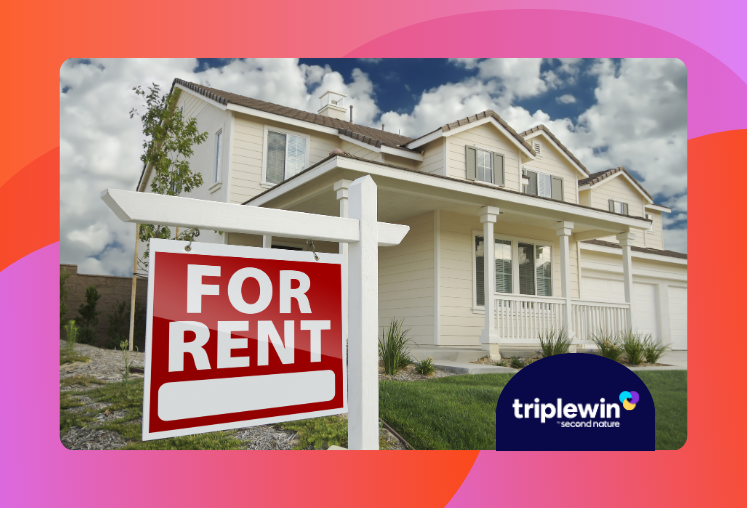Dealing with pets in rental properties can be tricky. While our furry friends bring comfort and joy to many, they can also cause issues for property managers as well as property owners. That’s why it's essential to address the situation professionally and promptly when a tenant brings in an unauthorized pet.
In this blog, we’ll discuss:
- What a pet violation letter to the tenant is
- The process of confirming an unauthorized pet lease violation
- How to write a pet violation letter to the tenant
And bonus: we’ll share a free pet violation letter to tenant template you can customize to help you through the process.
Note on Language: At Second Nature, we like to say “resident” rather than “tenant,” but will use the terms interchangeably since many property managers have official terminology around these templates.
What Is a Pet Violation Letter to Tenant?
A pet violation letter is a formal notice sent to tenants when they’ve violated the terms of their lease agreement by having an unauthorized pet. This type of letter serves to notify the pet owner of the violation and the consequences of not resolving it. The primary goal is to ensure compliance with the lease while maintaining a respectful and professional relationship with the tenant.
The letter is typically sent after a property manager has confirmed that a tenant is keeping an unauthorized pet in their rental unit. This can be an issue when a lease explicitly prohibits pets, or when a pet does not meet specific criteria outlined in the lease, such as size or breed restrictions. (Note that while dog breeds often associated with aggressive behavior include pit bulls, dobermans, German shepherds, and others - actual breed restrictions vary by state).
Put simply, unauthorized pets are animals kept by tenants without the property manager's consent. This issue can arise for a variety of reasons, including the tenant's desire to avoid pet deposits, fees, or restrictions, or simply because the tenant wasn't aware of the rules. Regardless of the cause, it’s important to address the situation before it escalates.
Property managers might enforce a no-pets rule for several reasons, including protecting the property from potential damage, minimizing noise, or reducing allergens that might affect future tenants.
There are also legal considerations to keep in mind, especially regarding service animals and emotional support animals (ESA), which we’ll cover later in this post.
Pet violation in the lease agreement
A rental agreement often includes a pet policy outlining what is and isn’t allowed. Some common restrictions might include weight limits, breed restrictions, and behavioral requirements. For instance, lease terms might allow pets under 25 pounds or prohibit aggressive breeds. There could also be rules about how many pets are allowed or requirements for pet insurance.
Property managers have the right to enforce no-pets policies, and this is generally supported by law. However, enforcement must be consistent and in line with the lease agreement. If a tenant violates the pet policy, the property manager can request that the pet be removed or even take legal action if the tenant refuses to comply.
An important caveat is that you need to be familiar with state laws as well as federal laws regarding pets. Service animals, for example, are protected under the Americans with Disabilities Act (ADA). This means that even if your lease has a no-pets policy, you must accommodate service animals without charging additional fees. Emotional support animals are a bit different from service animals – they’re protected under the Fair Housing Act, but property managers are allowed to ask for proper documentation.
As a disclaimer, we urge you to obtain legal advice to ensure you are not stepping on any local regulations, as this blog post does not constitute formal legal guidance!
Related: If you do offer pets in your rental property, check out our blog - Pet Policy for Renters: Best Practices for Property Managers to find out more.
Examples of unauthorized pet scenarios
Unauthorized pets can cause a range of issues, from minor inconveniences to significant property damage. Here are a few examples of common scenarios:
- Odors: Pets, particularly dogs and cats, can leave behind strong odors that linger in a rental unit long after they’re gone. These smells can be tough to eliminate and may require professional cleaning.
- Fur: Pet fur can accumulate on carpets, furniture, and air ducts, leading to additional cleaning expenses.
- Damage: Pets can cause visible damage to a rental unit. Dogs might chew up carpet or scratch wood floors, while cats could damage walls or furniture.
It’s important to document these issues when addressing unauthorized pets. Clear evidence will help you communicate the problem to the tenant effectively, as well as help you deal with any ramifications around security deposits.
Exceptions to the rule
Not all pets can be treated the same under the law. Service animals and ESAs have special protections that property managers must respect. A tenant with a disability is entitled to keep a service animal, even if the property has a no-pets policy. These animals are not considered pets but rather essential aids for their owners.
Emotional support animals are slightly different. While they don’t have the same legal status as service animals, property managers must still make reasonable accommodations under the Fair Housing Act. If a tenant provides a valid ESA letter from a licensed mental health professional, the property manager must allow the animal unless it poses a direct threat to the safety of others or causes significant property damage.
When presented with an ESA letter, be careful not to overstep privacy laws when verifying its legitimacy. A respectful approach is key to maintaining a good relationship with the tenant while upholding the property’s rules.
Related: Pet Screening 101: How Top Property Managers Do It
Confirming an Unauthorized Pet Lease Violation
Before sending out a pet violation letter, it’s essential to confirm that the tenant is actually in violation of the lease agreement. This might involve observing the pet directly, collecting evidence from neighbors, or discovering signs of a pet in the unit, such as fur or odors. Once you have confirmed the violation, check the lease to ensure the tenant is aware of the policy they’ve breached.
When addressing unauthorized pets, start by communicating clearly with the tenant. Explain the violation and give them an opportunity to correct the issue. In some cases, a simple conversation can resolve the problem without the need for a formal cure or quit notice.
If the tenant refuses to comply, you may need to take further action, such as issuing a formal pet violation letter or, in extreme cases, beginning the eviction process.
Writing a Pet Violation Letter to the Tenant
When crafting a pet violation notice, clarity and professionalism are crucial. Here are the key elements that should be included:
- Tenant’s information: Start with the tenant’s name, address, and the date of the letter.
- Violation description: Clearly state the violation, including the specific pet policy they’ve breached. Mention the lease agreement and the relevant clauses.
- Evidence: Include any evidence you’ve gathered, such as photos or reports from neighbors.
- Resolution options: Outline what the tenant needs to do to resolve the issue, whether that means removing the pet or paying additional fees.
- Deadline: Provide a deadline for compliance. This gives the tenant a clear timeframe to address the violation.
- Consequences: Explain the consequences of failing to comply, such as fines or legal action.
- Contact information: Include your contact information for any questions or concerns.
Here’s a template to guide you through the process.
Pet Violation Letter to Tenant Template
[Your Name]
[Your Address]
[City, State, ZIP Code]
[Phone Number]
[Email Address]
[Date]
[Tenant’s Name]
[Tenant’s Address]
[City, State, ZIP Code]
Dear [Tenant’s Name],
This letter is to inform you that we have discovered a violation of your lease agreement regarding pets. Our records indicate that you currently have an unauthorized [type of pet] in your rental unit at [property address]. According to your lease, pets are not permitted without prior approval and proper documentation.
We have attached evidence of this violation, including [brief description of evidence]. Please review your lease agreement, specifically [mention relevant section], which outlines our pet policy.
To resolve this issue, we request that you [describe resolution, e.g., remove the pet from the premises or provide the necessary documentation]. Please comply with this request by [insert deadline], or further action may be taken, including fines or legal proceedings.
If you have any questions or would like to discuss this matter further, please do not hesitate to contact us at [phone number or email].
We appreciate your prompt attention to this matter and hope to resolve it as soon as possible.
Sincerely,
[Your Name]
[Title]
[Company Name]
If this is the first violation, a warning letter may suffice and can leave space for a humane and respectful resolution.
In this case, follow up with a check-in after a suitable period. If the tenant has failed to comply, follow up with a more formal notice and be prepared to escalate the situation as needed, up to and including an eviction notice.
Final Thoughts
Managing a rental property comes with many responsibilities, and handling unauthorized pets is just one of them. By staying on top of these issues and communicating clearly with tenants, you can protect your property while fostering a positive tenancy experience for the resident.
For more tips on improving the resident experience, learn about Second Nature’s Resident Benefits Package.



